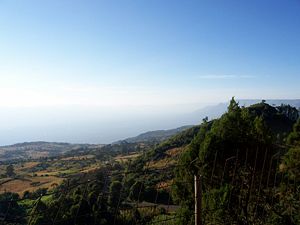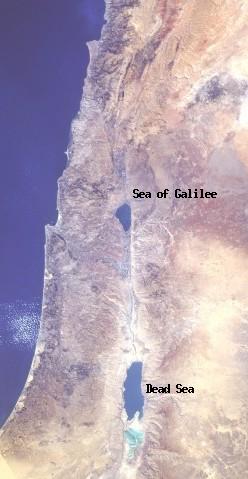Great Rift Valley
The Great Rift Valley is a vast geographical and geological feature that runs north to south for around 6,000 km, from northern Syria in Southwest Asia to central Mozambique in East Africa. The valley varies in width from thirty to one hundred kilometers, and in depth from a few hundred to several thousand meters. It was named by the explorer John Walter Gregory.
Geography
The northernmost part of the Rift forms the Beqaa Valley in Lebanon . To the south, in Israel, it is known as the Hula Valley separating between the Galilee mountains and the Golan Heights. Farther south, the valley becomes the Jordan River, which flows southward through Lake Hula into Lake Tiberias in Israel and then continues south through the Jordan Valley into the Dead Sea on the Israeli-Jordanian border. From the Dead Sea southward, the Rift is occupied by the Wadi Arabah and then the Gulf of Aqaba and the Red Sea.
The southern end of the Red Sea marks a fork in the rift. The Afar Triangle or Danakil Depression of Ethiopia and Eritrea is the probable location of a triple junction, which is possibly underlain by a mantle plume. The Gulf of Aden is an eastward continuation of the rift - before the rift opened, the Arabian Peninsula was attached to the Horn of Africa - and from this point the rift continues as part of the mid-oceanic ridge of the Indian Ocean. In a southwest direction the fault continues as the Great Rift Valley, which split the older Ethiopian highlands into two halves.
In eastern Africa the valley divides into the Eastern Rift and the Western Rift.
The Western Rift, also called the Albertine Rift, is edged by some of the highest mountains in Africa, including the Virunga Mountains, Mitumba Mountains, and Ruwenzori Range, and contains the Rift Valley lakes, which include some of the deepest lakes in the world (up to 1,470 meters deep at Lake Tanganyika). Lake Victoria, the second largest freshwater lake in the world, is considered part of the Rift Valley system although it actually lies between the two branches. The other Great Lakes are also formed by the rift.
In Kenya the valley is deepest to the north of Nairobi. As the lakes in the Eastern Rift have no outlet to the sea, these lakes tend to be shallow and have a high mineral content as the evaporation of water leaves the salts behind. For example, Lake Magadi is almost solid soda (sodium carbonate), and Lake Elmenteita, Lake Baringo, Lake Bogoria, and Lake Nakuru are all strongly alkaline, while Lake Naivasha needs to be supplied by freshwater springs to support its biological variety.

Geothermal activity
The formation of the Rift Valley continues, probably driven by mantle plumes and ultimately a result of the African superswell. The associated geothermal activity and spreading at the rift has caused the lithosphere to thin from a typical 100 km thickness for continents to a mere 20 km. Though it is common for one arm of a triple junction to fail, if spreading continues the lithosphere may rupture several million years hence, splitting eastern Africa off to form a new landmass. In short, this will lead to the formation of a new mid-ocean ridge.
The volcanic activity at this site and unusual concentration of hotspots has produced the volcanic mountains Mount Kilimanjaro, Mount Kenya, Mount Karisimbi, Mount Nyiragongo, Mount Meru and Mount Elgon as well as the Crater Highlands in Tanzania. The Ol Doinyo Lengai volcano remains active, and is currently the only natrocarbonatite volcano in the world.
Discoveries in human evolution
The Rift Valley has been a rich source of fossils that allow study of human evolution, especially in an area known as Piedmont. There is no reason to conclude that early hominids were confined to East Africa, but because the rapidly eroding highlands filled the valley with sediments, a favorable environment for the preservation of remains was created. The bones of several hominid ancestors of modern humans have been found there, including those of "Lucy", a nearly complete australopithecine skeleton, which was discovered by anthropologist Donald Johanson. Richard and Mary Leakey have also done significant work in this region.
ReferencesISBN links support NWE through referral fees
- Donald Johanson and Blake Edgar, From Lucy to Language, 1996. Simon & Schuster, New York, NY. ISBN 0684810239
- Nigel Pavitt, Africa's Great Rift Valley, 2001. Harry N. Abrams, New York, NY. ISBN 0810906023
- Richard E. Leakey, The Making of Mankind, 1981. E.P. Dutton, New York, NY. ISBN 0525150552
External links
Credits
New World Encyclopedia writers and editors rewrote and completed the Wikipedia article in accordance with New World Encyclopedia standards. This article abides by terms of the Creative Commons CC-by-sa 3.0 License (CC-by-sa), which may be used and disseminated with proper attribution. Credit is due under the terms of this license that can reference both the New World Encyclopedia contributors and the selfless volunteer contributors of the Wikimedia Foundation. To cite this article click here for a list of acceptable citing formats.The history of earlier contributions by wikipedians is accessible to researchers here:
The history of this article since it was imported to New World Encyclopedia:
Note: Some restrictions may apply to use of individual images which are separately licensed.


